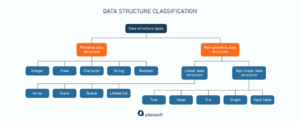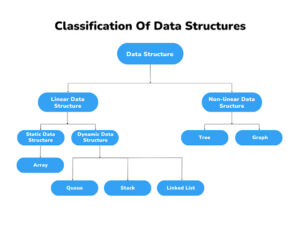What are the different types of data structures?
Now, consider something like the 11-character code banks use – it’s another example of a data structure. The first four letters tell you the bank’s name, the fifth one is usually a zero, and the last six characters represent the specific branch. In our exploration journey at tech articles for students, we’ll dive into different types of data structures.
Data structures can be split into two main groups:
1. Primitive Data Structures: These store data of only one kind, like integers, decimals, characters, and true/false values.
2. Non-Primitive Data Structures: They can store different kinds of data. Examples include arrays, linked lists, and trees. These are built from primitive data structures.
Data structures are also categorized based on how they arrange data:
1. Linear Data Structures: Here, data is arranged one after the other in a sequence. Examples are arrays and linked lists.
· Static Data Structures: These have a fixed size set during compilation. The size can’t be changed afterwards.
· Dynamic Data Structures: They don’t have a set size and can change during the program’s execution.
2. Non-Linear Data Structures: Data isn’t in a straight line; instead, they form a hierarchy. Examples are trees and graphs.
Different Types of Data Structures:
1. Arrays:
Arrays are one of the simplest and most fundamental data structures. They consist of a collection of elements stored in contiguous memory locations.
Arrays are like a line of boxes where you can put things. Each box holds one thing, and they’re all lined up right next to each other. When you want to get something from the array, you just remember which box it’s in, and you can grab it really quickly. This makes finding things in an array super-fast. But there’s a catch. Once you set up the line of boxes, you can’t easily make it longer or shorter. If you need more boxes, you might have to move everything to make space, which takes time. Also, if you want to take something out or add something new, it can be a bit tricky because you have to shift everything around.
So, arrays are great for organizing stuff and finding things quickly, but they’re not so great if you need to change the number of boxes often.
2. Linked Lists:
Linked lists are linear data structures composed of nodes, where each node contains a data element and a reference (or pointer) to the next node in the sequence.
Linked lists are like a chain of connected blocks, where each block holds some information and points to the next block in line. Unlike arrays where everything has to be placed next to each other, linked lists don’t need to be in one solid block. This means we can add or remove blocks easily, making it great for tasks where we’re constantly adding or removing things. However, because each block needs to point to the next one, it takes a bit more effort to find specific blocks compared to arrays.
3. Stacks:
Stacks are dynamic data structures that adhere to the Last In, First Out (LIFO) principle.
Think of a stack like a stack of plates. You put a new plate on top of the stack, and when you want to take a plate, you take the one from the top. That’s the Last In, First Out (LIFO) rule. Stacks are useful in situations where you need to keep track of things in the order they were added and remove them in reverse order. For example, when you’re solving a problem and need to backtrack to a previous step, or when you’re evaluating math expressions. Stacks are like a handy tool for managing tasks in a particular order.
4. Queues:
Queues are linear data structures that follow the First In, First Out (FIFO) principle.
Imagine a queue like a line at a store. The first person to join the line is the first one to be served, just like how the First In, First Out (FIFO) principle works. People join the line at the back and leave from the front when it’s their turn to be served. Queues are useful for tasks where things need to be done in the order they arrive. For example, when tasks are scheduled to be completed in the order they were requested, or when messages need to be processed as they come in. Just like how you can use a line to manage who gets served next, queues help keep things organized fairly and efficiently.
5. Trees:
Trees are hierarchical data structures consisting of nodes connected by edges. They have a root node at the top and each node may have zero or more child nodes.
Think of a tree like a family tree. At the top, you have the oldest generation, which is like the root of the tree. Each person in the family tree is a node, and they can have children, who are connected to them like branches. Trees help organize information in a way that shows relationships between different pieces of data. For example, in a company’s organizational chart, the CEO is at the top (root), and then there are managers, who have employees working under them. Different types of trees have special rules. For example, in a binary tree, each node can have at most two children. In a binary search tree, the nodes are organized in a way that makes searching for specific values faster.
Trees are handy for quickly finding information and organizing data hierarchically, just like how a family tree helps you see who is related to whom.
6. Heaps:
Heaps are specialized tree-based data structures that satisfy the heap property, which specifies the relationship between parent and child nodes.
Imagine a heap like a pile of books on a table. Each book has a priority level, and the heap keeps them organized based on their priority. The special thing about heaps is how they arrange the books. In a heap, the most important book (the one with the highest priority) is always at the top. And if you need to add a new book or remove one, the heap makes sure the most important book stays at the top.
Heaps are often used for things like managing tasks based on their priority levels. For example, in a hospital, patients with more urgent conditions get treated first, just like the most important books in a heap are dealt with first. There are different types of heaps, like the binary heap and the Fibonacci heap, each with its own strengths and weaknesses. But they all help keep things organized based on priority, making it easier to handle tasks efficiently.
7. Hash Tables:
Hash tables are data structures that store key-value pairs, allowing for fast retrieval of values based on their associated keys.
Think of a hash table like a big table with lots of slots. Each slot has a unique number, and you can put something in each slot. But instead of remembering which slot you put something in, you use a special formula (hash function) to figure out where to put it and where to find it later. This is really helpful when you have a lot of things to remember and you want to find them quickly. For example, if you have a phone book, you can use the person’s name (the key) to quickly find their phone number (the value). In a hash table, the name would be the key, and the phone number would be the value.
But sometimes, two things might need to go in the same slot (hash collision), which can slow things down a bit. And if the table gets too full, you might need to resize it to keep things running smoothly. Overall, though, hash tables are great for quickly finding stuff, which is why they’re used in things like search engines and databases.
8. Graphs:
Graphs are versatile data structures consisting of nodes (vertices) and edges that connect pairs of nodes. Graphs can be directed or undirected, weighted or unweighted, and cyclic or acyclic.
Think of a graph like a map. The cities on the map are the nodes, and the roads connecting them are the edges. Graphs can represent many different kinds of relationships, like how people are connected on social media, how cities are connected by highways, or how computers are connected in a network. Graphs can have different features. They can show directions on the edges, like one-way streets, or they can be undirected, like two-way streets. They can also have weights, which represent things like the distance between cities or the cost of a flight ticket.
There are special algorithms to explore and understand graphs, like going through every city in the shortest way possible (breadth-first search) or exploring one path as far as possible before backtracking (depth-first search). These help us analyse and make sense of the relationships represented by graphs.
Frequently asked questions on What are the different types of Data Structures?
Image Rights: Learn Loner
Q1. What is a data structure?
ANS. A data structure is a way of organizing and storing data in a computer’s memory.
Q2. What are examples of primitive data structures?
ANS. Examples of primitive data structures include integers, decimals, characters, and true/false values.
Q3. What are examples of non-primitive data structures?
ANS. Examples of non-primitive data structures include arrays, linked lists, and trees.
Q4. How are linear data structures categorized based on memory allocation?
ANS. Linear data structures are categorized into static data structures (fixed size) and dynamic data structures (size varies).
Q5. What are the main characteristics of stacks?
ANS. Stacks follow the Last In, First Out (LIFO) principle and are commonly used for managing tasks in a particular order.
Q6. How do queues operate?
ANS. Queues follow the First In, First Out (FIFO) principle and are useful for tasks where things need to be processed in the order they arrived.
Q7. What is a heap and how does it maintain data?
ANS. A heap is a specialized tree-based data structure that organizes elements based on their priority levels, ensuring the most important element is always at the top.
Q8. What is the purpose of hash tables?
ANS. Hash tables store key-value pairs, allowing for fast retrieval of values based on their associated keys.
Wrap Up:
In conclusion, data structures are like tools that help organize and manage data in computers. They come in different types, like arrays, linked lists, stacks, queues, trees, heaps, hash tables, and graphs, each with its own unique features and uses. Understanding these structures and how they work allows programmers to build efficient and scalable solutions for various computational problems. To understand data structures and concepts like AI, ML, Cloud and more, you can visit the techarticles website where we provide brief articles and blogs to brush up on your knowledge.
By categorizing data structures based on their properties and arrangements, such as linear or non-linear, static or dynamic, programmers can choose the most suitable structure for their specific needs. Whether it’s organizing data in a sequential order like arrays or linked lists, managing tasks with stacks or queues, representing hierarchical relationships with trees, prioritizing tasks with heaps, efficiently retrieving values with hash tables, or modelling complex networks with graphs, data structures play a vital role in solving real-world problems in computer science and programming. Their effective utilization is essential for designing optimized algorithms and systems capable of handling diverse computational tasks efficiently.




